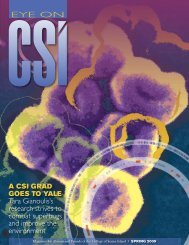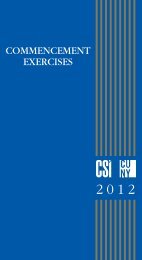csi undergraduate conference on research, scholarship ... - CSI Today
csi undergraduate conference on research, scholarship ... - CSI Today
csi undergraduate conference on research, scholarship ... - CSI Today
You also want an ePaper? Increase the reach of your titles
YUMPU automatically turns print PDFs into web optimized ePapers that Google loves.
Research Poster Presentati<strong>on</strong>sP O S T E R 8 2Effect of Ps-tau <strong>on</strong> the OmmatidiaTransgenic DrosophilaJustin ChackoFaculty Mentor: Dr. Alejandra Al<strong>on</strong>soDepartment of BiologyAlzheimer’s disease falls into a category with otherdiseases such as fr<strong>on</strong>totemporal dementia withParkins<strong>on</strong>ism linked to chromosome-17 and Pick’sdisease called tauopathies. Tauopathies are causedby the abnormal hyperphosphorylati<strong>on</strong> of themicrotubule associated protein tau. Tau binds toax<strong>on</strong>al microtubules and helps provideorganizati<strong>on</strong>, stability and functi<strong>on</strong>. The abnormalhyperphosphorylati<strong>on</strong> of tau is caused by enzymescalled kinases which phosphorylate specific serineand thre<strong>on</strong>ine residues. Phosphorylati<strong>on</strong> causes theadditi<strong>on</strong> of a negative phosphate group to theprotein causing c<strong>on</strong>formati<strong>on</strong>al changes. Normaltau c<strong>on</strong>tains approximately 3 moles of phosphateper mole of protein, while hyperphosphorylatedtau c<strong>on</strong>tains approximately 7-10 moles ofphosphate per mole of protein. The c<strong>on</strong>formati<strong>on</strong>alchange bought <strong>on</strong> by this excess phosphorylati<strong>on</strong>causes the formati<strong>on</strong> of filaments. Thephosphorylati<strong>on</strong> of tau decreases it interacti<strong>on</strong>with microtubules and through in-vitro studies itwas shown that sites Thr212, Ser214, Thr231,Ser235 and Ser262 are major sites for inhibiti<strong>on</strong> oftau-microtubules binding. Through site-directedmutagenesis sites Thr212, Thr231 and Ser262 werechanged to a glutamic acid. The negative charge ofthe glutamic acid side chain can mimic the effect ofthe negative phosphate group inhyperphosphorylated tau. Transgenic fliesc<strong>on</strong>taining this pseudophosphorylated tau werecreated and regulati<strong>on</strong> of thepseudophosphorylated tau is c<strong>on</strong>trolled by a GAL4inducible system. The transgenic drosophilac<strong>on</strong>taining pseuophosphorylated tau allows thestudy of tau hyperphosphorylati<strong>on</strong> in-vivo and themechanism of tau phosphorylati<strong>on</strong> inducedtoxicity. The effect of tau toxicity caused by thepseudophosphorylated tau can be seen through theeffect of its expressi<strong>on</strong> <strong>on</strong> the eyes of transgenicdrosophila. The expressi<strong>on</strong> of the abnormal tau inthe drosophila eyes is examined using scanningelectr<strong>on</strong> microscopy (SEM) which provides highresoluti<strong>on</strong> and magnificati<strong>on</strong>. This is optimal to seethe effect of pseudophosphorylated tau <strong>on</strong> theommatidia of drosophila eyes.P O S T E R 8 3Fabricati<strong>on</strong> of PorousSuperhydrophobic SurfacesKristi Abbatemarco, Mark BarahmanFaculty Mentor: Dr. Alan Ly<strong>on</strong>sDepartment of ChemistrySuperhydrophobic surfaces exhibit variousproperties that can be used to facilitate a broadrange of applicati<strong>on</strong>s. Am<strong>on</strong>g these properties arelarge c<strong>on</strong>tact angles and decreased hydrodynamicdrag. Superhydrophobic surfaces are limited,however, by the maximum water pressuredifference that can be sustained at the air/waterinterface. Above this pressure, the liquid transiti<strong>on</strong>sto a wetted, n<strong>on</strong>-superhydrophobic state. Our lab isdeveloping a method to increase the stability ofsuperhydrophobic surfaces and maximize thepressure of water that can be supported. Wecounter the liquid pressure by introducing gaspressure from below the surface. A porous surfaceto support the superhydrophobic structures isnecessary to apply counter-pressure.In this poster we describe the fabricati<strong>on</strong> ofsuperhydrophobic surfaces <strong>on</strong> porous fabricmeshes to create superhydrophobic membranesusing printing technologies. Fabric meshes ofdifferent types were evaluated based <strong>on</strong> materialcompositi<strong>on</strong> as well as pore size. The pore sizeneeds be small enough to support printing whilelarge enough to be financially feasible. A robotic3D printer was used to dispense arrays ofpolydimethysiloxane features, which render thesurface superhydrophobic, by a previouslyestablished method. Several modificati<strong>on</strong>s to theprotocol were necessary as a result of the changein substrate. We used double-sided tape <strong>on</strong> a glassslide to flatten the substrate fabric and hold it inplace for printing. We will present specific changesto printing parameters and discuss patternsobserved, as well as approaches to increasingsurface stability.64
















